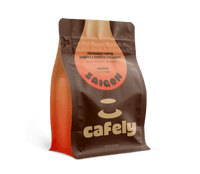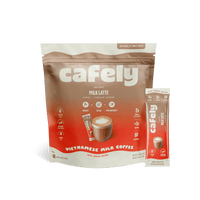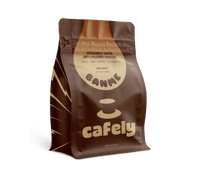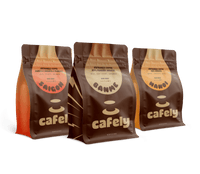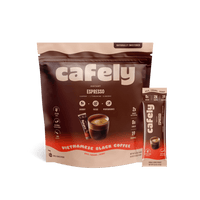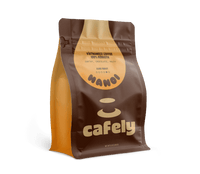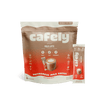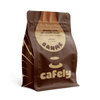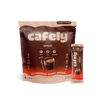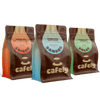Vietnamese coffee is known for its bold flavor, rich aroma, and energizing kick. It’s typically prepared using a traditional phin filter.
But a lot more actually goes into this iconic drink than you might expect. There are approximately four different kinds of Vietnamese coffee beans — depending on how you look at it.
1. Coffee Species
There are more than 120 different species of coffee — but only four are actually used to make the classic beverage: Coffea robusta, Coffea arabica, Coffea excelsa, and Coffea liberica.
Out of these four, only two are prevalent in Vietnam:
- Robusta — Cà phê vối is the most popular Vietnamese coffee. Traditional Vietnamese coffee is made exclusively from Coffea robusta, which is known for its high caffeine content and slightly bitter, nutty profile.
- Arabica — Cà phê chè is the most widely grown coffee in the world. Arabica is known for its smooth flavor and accounts for approximately 60% of the world’s total coffee production.
In this article, we’ll explore various types of Vietnamese coffee and some unique varieties created using unorthodox methods. But first, here's a quick view of the differences between arabica and robusta beans.

A) Robusta Coffee
Coffea caniphora accounts for approximately 90% of coffee production in Vietnam and is the most popular coffee bean in the country. It contains almost twice the amount of caffeine compared to arabica and has a much stronger flavor. Robusta beans are generally grown in the Central Highlands of Vietnam, where the climate, soil, and altitude are ideal conditions for it to thrive.
True to its name, robusta is a hardy plant with an intense nutty and chocolatey flavor. Robusta beans like our HaNoi are dry processed and dark roasted, which enhances the deep flavor associated with a strong coffee. Traditionally, a cup of robusta is combined with sweetened condensed milk to counteract the bitterness.
Robusta contains more antioxidants than arabica and less fat and sugar. Unlike arabica, the plant has a high yield and requires little maintenance to survive. It copes well with rising temperatures and is highly resistant to pests, disease, and changeable weather, flourishing even at low altitudes.
Related: What’s the Difference Between Robusta & Arabica Coffee?
There are 3 main types of robusta coffee grown in Vietnam:
Catimor Coffee
Catimor coffee is a hybrid blend of arabica and robusta. It has the high-yielding quality of robusta — being resistant to diseases such as rust that cause defoliation and unstable yields — but maintains the desirable flavor profile of arabica with an herbal undertaste. Catimor is a sustainable choice for regions where growing arabica is difficult, and it makes up the majority of arabica production in Vietnam.
S18 (or Screen 18)
Screen 18 doesn’t refer to a specific variety of coffee — rather, it refers to a particular size grading for beans grown in Vietnam and other parts of Southeast Asia.
The number 18 refers to the diameter of the sieves in screens used to separate large coffee beans from smaller coffee beans. The holes are about 1/64th of an inch.
The larger beans classified as S18 are considered to have a distinctive flavor and quality profile that makes it ideal for brewing Vietnamese-style coffee. S18 beans are typically filtered out from other beans and sold at a higher premium for this reason.
Peaberry Robusta (AKA “Culi” Coffee)
Cà phê culi beans (peaberry robusta) have a very distinctive shape — they’re dense and round in contrast to regular coffee beans that have two iconic flat-sided halves.
Peaberries are a natural mutation of the coffee plant. Instead of growing two seeds per berry, peaberry mutations have just one rounded berry inside.
Peaberry robusta is highly sought after (and expensive) for two reasons — its rarity (only 10% of a given crop yields peaberries) and its intense flavor and caffeine profiles (both cherished qualities in Vietnamese coffee).
Check out our 100% Peaberry Robusta Blend: BanMe
B) Arabica Coffee
Coffea arabica is the most popular coffee in the world, but it is pushed into second place in Vietnam by the aforementioned robusta. Renowned for its slightly acidic yet smooth flavor profile, many people consider it to be the highest-quality coffee because it lacks the bitterness prevalent in robusta. People have described the flavor of arabica coffees like our DaLat Coffee as fruity and sweet with a floral aroma.
However, arabica has its drawbacks. It’s much harder to grow than robusta. It’s delicate, susceptible to destruction caused by pests, disease, and weather variations, and requires very specific growing conditions to survive. To ensure successful growth, arabica must be grown at an altitude of at least 2,000 feet with plenty of rainfall. It requires mild temperatures and is a smaller plant than robusta, meaning it naturally has a smaller yield.
There are three types of arabica coffee in Vietnam: Typica, catuai, and moka (bourbon).
Typica Coffee
Typica is the oldest type of coffee in the world and is widely cultivated in DaLat. However, because production is low, it has largely been replaced with other varieties over the years. Today, it is most often used in coffee blends and is characterized by a sweet and sour taste that's reminiscent of apples.
Catuai Coffee
Catuai is a hybrid of two arabica varieties. It has a good yield and a sweet, fruity taste and aroma, but it’s not resistant to coffee leaf rust, fungal infections, diseases, or pests. This makes it more challenging to grow successfully.
Moka (Bourbon) Coffee
With a flavor profile that has been described as a combination of chocolate and fruit, moka is a cultivar of typica. Bourbon coffee beans have a lower yield rate than other arabica beans.
Related: Where to Buy Authentic Vietnamese Coffee
2. Other Types of Specialty Vietnamese Coffee
Although robusta is the most popular choice for Vietnamese coffee, closely followed by arabica, certain regions swear by a series of other types of coffee — some of which may sound a little strange to the average Westerner’s ear…
A) Cherry Coffee

Cà phê mít is sometimes referred to as ‘jackfruit coffee’ because the plant bears a striking resemblance to the jackfruit tree. These beans have a mixed profile — spicy undertones and a fruity fusion of chocolate and cherry without any underlying bitterness. They are classed as Coffea excelsa or Coffea liberica and are popular with people who prefer a milder-tasting cup of coffee.
B) Weasel Coffee

Weasel coffee (cà phê chồn) is a delicacy in Vietnam and one of the most luxurious and expensive coffee beans you can buy.
Despite its origins — and the fact that we can’t help but question how it came to be discovered — many people prefer the flavor of weasel coffee to regular varieties.
This coffee bean was discovered quite by accident when Vietnamese laborers found coffee beans in weasels’ droppings. The animals are particular about the coffee cherries they eat — offering a layer of quality control — and choose the ripest for consumption, then excrete them. Coffee was a lucrative venture, and the laborers were not allowed to try it — meaning that this type of coffee was discovered as a result of their rebellion or desperation, or both.
The workers took the dung beans home, washed them thoroughly, and made the coffee secretly. They soon discovered that the weasel coffee tasted better than the coffee that came directly from the plant.
Research undertaken by Professor Massimo Marcone at the University of Guelph in Canada subsequently uncovered enzymes in a weasel’s digestive tract that change the molecular structure of the beans and produce a more mellow flavor.
C) Elephant Coffee

Cà phê voi, similarly to weasel coffee, is sourced from elephant dung. The elephants are fed with fresh, ripe arabica coffee beans that have been mixed into their food. Once excreted, the beans are carefully cleaned and transformed into a unique variety of coffee.
You might be forgiven for questioning how these somewhat labor-intensive and time-consuming methods have come to fruition. It’s hard to comprehend how a product made from animal dung has gained so much popularity both in terms of its flavor and hefty price tag. Those who have tried elephant coffee have described it as a fusion of arabica’s richness combined with earthy notes for an extraordinary coffee experience.
D) Butter Coffee

Traditionally, coffee grown in Vietnam was first glazed with butter before entering the roasting oven. This helped create a more even and thorough roast, especially when performing darker roast levels. Coffee roasted this way has greater depth of flavor and a more creamy aftertaste.
It’s rare to find true butter-roasted coffee these days because most large commercial roasters refuse to use butter in their roasters.
Cafely owns a dedicated butter-roast machine for preparing its most traditional Vietnamese coffee blend — the SaiGon OG.
3. Roast Level

The third classification we can use to differentiate Vietnamese coffee beans is the roast level. The most common roast used in Vietnam is the dark roast, but you can also find full-French roasts (darker than dark), medium-dark, medium roast, and in very rare cases, light roast.
The darker roast styles work better with the strong, bold flavors inherent to coffees prepared with a traditional Vietnamese phin filter.
Light roasts are typically considered too weak and acidic for Vietnamese coffee drinkers.
FAQs: Types of Vietnamese Coffee Beans
Still have questions? Here are some of the most commonly asked questions we get about Vietnamese coffee.
1. Where should I source my Vietnamese coffee beans?
Asian markets might carry Vietnamese coffee beans, but the problem is quality and freshness. Online is the better option, and you can find the best coffee online from artisan brands and specialty roasters.
Check out our selection at Cafely for the freshest Vietnamese coffee.
If you aren’t sure which type of coffee is for you, we recommend trying one of our bundles (the Awaken Bundle or Harmony Bundle). We also stock Vietnamese robustas (HaNoi blend and BanMe Coffee), Vietnamese arabica (DaLat roasts), and mixed blends (SaiGon Coffee and DaNang blend) individually.
It is important to always buy coffee from a reputable supplier and check the roast date to ensure your coffee is as fresh as possible.
2. Is Vietnamese coffee sustainable?
Vietnamese farmers have adopted various initiatives and methods to ensure their coffee production is as organic and ethically responsible as possible. Many farmers have reduced the use of chemical pesticides and fertilizers to maintain the integrity of the soil and protect the environment. They have also implemented rules to prevent deforestation and encourage responsible land use. Fair trade practices have been established to ensure fairer wages and working conditions for farmers.
3. What types of Vietnamese coffee drinks are there?
Vietnam is home to some unique coffee flavors and brewing methods, both of which have established it as a powerhouse in the global coffee industry. The most popular and traditional coffee drink is simply called Vietnamese coffee. Vietnamese coffee is prepared with a phin filter and mixed with sweetened condensed milk. Other variations include rich egg coffee, coconut coffee, and iced coffee, which are all common beverages in Vietnam.
4. What is the history of Vietnamese coffee beans?
Coffee was introduced to Vietnam by the French in the 1800s. Although the drink has steadily become more popular and is now a huge part of the country’s culture, the coffee industry didn’t take off in Vietnam until the 1990s, when it became a major producer and exporter of coffee.
